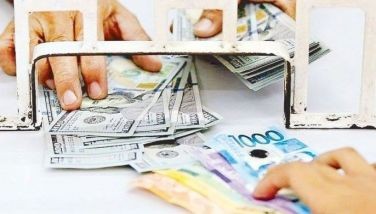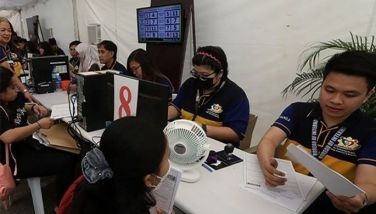Two pesos per dollar unsustainable after independence: Phl economic history

Philippine independence was on schedule to be delivered on July 4, 1946 just a few months after the end of the Second World War. The economy was vastly devastated by four years of Japanese occupation and the war for liberation which brought in further destruction.
These unexpected conditions changed the nature of the recovery and the path toward true independence.
Liberation and the return of the peso exchange rate. With total productive output down to around 30 percent of prewar output (*reference at end, below) and the export industries almost badly flattened, the country was in a very weak position.
It just had no capacity to sustain a two to one peso exchange rate, short of reliance on foreign aid and grants. The old exchange rate, however, was continued as the basis of relations between the peso and the American dollar.
The new Republic of the Philippines was the recipient of a generous amount of American economic transfers to help in the early recovery of consumption. Relief goods from abroad came and replenished exhausted food supplies. Further, there was a major economic adjustment program supported by the former colonial master – the United States.
New expenditures arising from the return of peace also brought in a high level of spending resurgence, which of course, stimulated the local recovery.
Moreover, large American military spending as a leftover of the war continued. The American military installations, through the 99-year leases, assured continued US military spending in the country.
Empire strikes back. The nature of economic relationships between former political master and colonial ward would be defined essentially by the pattern of adjustments that obtained during the commonwealth period (that is, before the war) as independence was contemplated.
The Constitution of 1935 that led to the establishment of the self-governing Commonwealth of the Philippines was approved by then American president (Franklin Roosevelt) without any directly reactive decision against the “nationalist” restrictions on foreign capital that were a major feature of that independence constitution.
Stage 2 of the American reaction was asserted in the definitive provisions of the Philippine Trade Act, signed into law by then president Harry Truman. This law stated in clear terms America’s commitment of economic and trade assistance to the former colony, outlining the process of economic adjustment during the long transition period that was to last until 1974.
Many of the general recommendations of the Joint Preparatory Committee on Philippine Affairs (Report of 1938) were taken into account, except that the adjustment period was made much longer than originally thought then. The devastation of the war of occupation and reconquest was the main reason.
The true mettle of American response to the nationalist provisions of the Philippine constitution showed itself, to rattle the nationalist sentiments within the newly independent republic.
The first was the requirement that the peso could not be changed in value without the approval of the United States president. This was a provision in the trade law which had to be drawn up as an agreement.
The second demand was integrated into the law that would make war damage payments to rehabilitate the economy. The Philippine Rehabilitation Act provided for the payment of $620 million (an amount that was very large at the time; think of converting this amount to today’s peso equivalent!) in war damage payments to the government and to private citizens who suffered from the war. The law was to be implemented on condition that American citizens be given national treatment regarding the implementation of economic provisions in the constitution.
By a direct vote in a referendum (on March 11, 1947), the “parity” provisions for American citizens was approved. Hence, the flow of resources to help expedite the rehabilitation period commenced in earnest and rapid fashion.
Although these provisions provided for a generous access to the American economy for Filipinos, nationalist sentiments were unnerved. During the time of former president Ramon Magsaysay, a revised agreement (named Laurel-Langley Agreement) eased some of the provisions and improved the terms of the preferential trade agreement.
For one, the peso was disengaged from American official control. However, the parity amendment remained unchanged.
The two-to-one dollar exchange rate was unsustainable in a weak economy. All these historical details serve as backdrop to the idea that the Philippine economy had its many weaknesses at the birth of independence.
Those preconditions would essentially have left the message that it would be difficult for the economy to be sustained at the fixed exchange rate of two pesos for one US dollar. Yet, the mindset of most Filipino leaders at the time was to keep the old rate of exchange.
Hence, domestic prices were falling from 1946 to 1950. That was because the trade position fostered by the early free trade arrangements with the US and the bounty of large US military spending surrounding the bases, the availability of aid made it possible to live high at that rate of exchange.
However, eventually, the resources that further enabled imports at the rate of two pesos to one dollar dried up. Imports would continue to outstrip the growth of means to pay for them when the bounties transferred from abroad dried up.
By 1949, import controls were needed. And by 1950, foreign exchange controls were needed to help refine the import control allocations to help in defining who would have the privilege to import.
The trade agreement, in addition to promoting exports for both countries also provided quotas for Philippine sugar and coconut exports to the US at their prewar levels. This, plus the support of the rehabilitation program involving war damage payments, helped to accelerate the recovery of traditional exports much faster.
As a result, the exports recovered early postwar and produced limited prosperity for these sectors. Also, exports of natural resources industry began to take a material importance. The result was that during the period of exchange controls these export industries produced rising export earnings for the economy.
If we look at the official rate of foreign exchange of the Philippine peso, central bank’s statistics report the official exchange rate of the peso was two pesos per one dollar until 1960.
{To be continued: The consequences of exchange controls.}
*See Sicat,, G.P., “The Philippine economy during the Japanese occupation, 1941-1945,” pp. 191-204, in Marcel Boldorf & Okazaki Tetsuji (2015), editors, Economies under Occupation: The hegemony of Nazi Germany and Imperial Japan in World War II, London & New York, Routledge.
My email is: [email protected]. For archives of previous Crossroads essays, go to: https://www.philstar.com/authors/1336383/gerardo-p-sicat. Visit this site for more information, feedback and commentary: http://econ.upd.edu.ph/gpsicat/
- Latest
- Trending






























